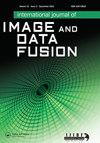粗分辨率散射计数据降尺度的信息融合方法
IF 1.8
Q3 REMOTE SENSING
International Journal of Image and Data Fusion
Pub Date : 2022-11-23
DOI:10.1080/19479832.2022.2144955
引用次数: 0
摘要
散射计数据(σ°)由于分辨率较粗(25 ~ 50 km)而限制了其应用。一些图像重建技术可用于生成高分辨率产品,但它们需要各种传感器参数和多集观测,使用起来很复杂。为此,本文提出了一种信息融合的方法来分解粗分辨率σ°积。粗分辨率后向散射信号包括短植被、土壤、城市和高层植被等多个土地覆盖类型的贡献,其信息可分别由归一化植被指数(NDVI)、植被温度条件指数(VTCI)和城市和森林覆盖度分数获得。分解这个粗分辨率像素,需要一个最优的权重信息来提供每个类的分布。由于土地覆盖类别在每个像元上的分布并不均匀,因此采用基于方差的融合方法来获得融合NDVI、VTCI和分数覆盖的最佳权重因子。这些权重因子用于将每个粗分辨率像素分解为高分辨率像素。将所建立的模型应用于Sentinel-1和Scatsat-1三级产品,取得了满意的结果。本文章由计算机程序翻译,如有差异,请以英文原文为准。
Information fusion approach for downscaling coarse resolution scatterometer data
ABSTRACT The applications of scatterometer data (σ°) are limited due to their coarser resolution (25–50 km). Some image reconstruction techniques are available to generate high-resolution products, but they require various sensor parameters and multiset observation, making them complex to use. Therefore, this paper proposes an information fusion approach to disaggregate the coarse resolution σ° product. The coarse resolution backscattering signal includes the contribution from more than one land cover class, such as short vegetation, soil, urban and tall vegetation, the information of which can be obtained from normalised difference vegetation index (NDVI), vegetation temperature condition index (VTCI), and fraction cover of urban and forests, respectively. Disaggregating this coarse resolution pixel, an optimum weight information is required that provides the distribution of each class. Since the distribution of land cover classes is not homogeneous for every pixel, a variance-based fusion approach has been used to obtain the optimum weight factors to fuse NDVI, VTCI, and fraction cover. These weight factors are used to disaggregate every coarse-resolution pixel into high-resolution pixels. The developed model is applied to Sentinel-1 and Scatsat-1 level-3 products, and the obtained results are quite satisfactory.
求助全文
通过发布文献求助,成功后即可免费获取论文全文。
去求助
来源期刊

International Journal of Image and Data Fusion
REMOTE SENSING-
CiteScore
5.00
自引率
0.00%
发文量
10
期刊介绍:
International Journal of Image and Data Fusion provides a single source of information for all aspects of image and data fusion methodologies, developments, techniques and applications. Image and data fusion techniques are important for combining the many sources of satellite, airborne and ground based imaging systems, and integrating these with other related data sets for enhanced information extraction and decision making. Image and data fusion aims at the integration of multi-sensor, multi-temporal, multi-resolution and multi-platform image data, together with geospatial data, GIS, in-situ, and other statistical data sets for improved information extraction, as well as to increase the reliability of the information. This leads to more accurate information that provides for robust operational performance, i.e. increased confidence, reduced ambiguity and improved classification enabling evidence based management. The journal welcomes original research papers, review papers, shorter letters, technical articles, book reviews and conference reports in all areas of image and data fusion including, but not limited to, the following aspects and topics: • Automatic registration/geometric aspects of fusing images with different spatial, spectral, temporal resolutions; phase information; or acquired in different modes • Pixel, feature and decision level fusion algorithms and methodologies • Data Assimilation: fusing data with models • Multi-source classification and information extraction • Integration of satellite, airborne and terrestrial sensor systems • Fusing temporal data sets for change detection studies (e.g. for Land Cover/Land Use Change studies) • Image and data mining from multi-platform, multi-source, multi-scale, multi-temporal data sets (e.g. geometric information, topological information, statistical information, etc.).
 求助内容:
求助内容: 应助结果提醒方式:
应助结果提醒方式:


